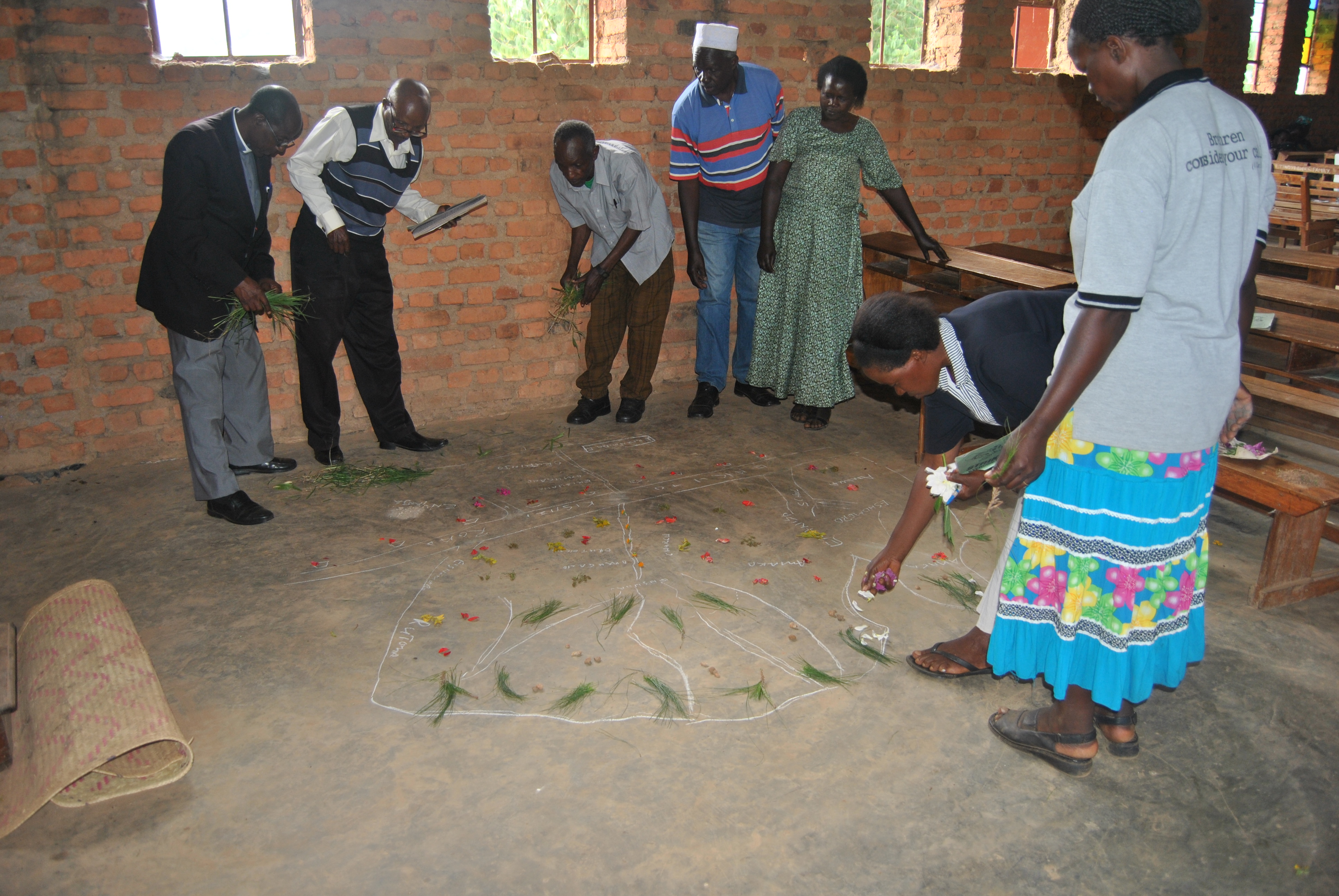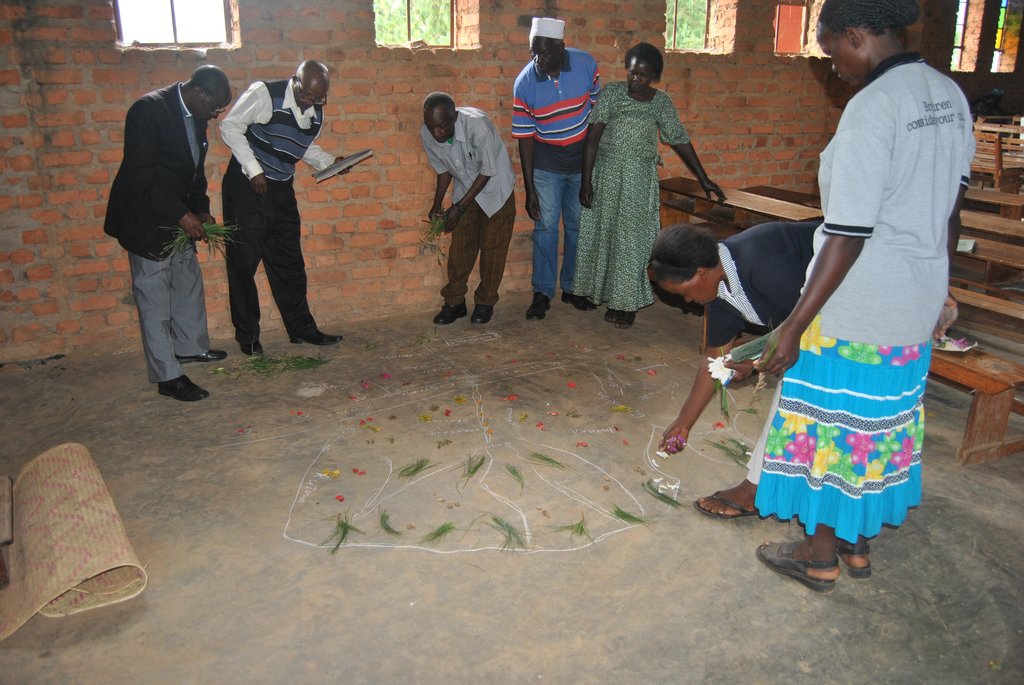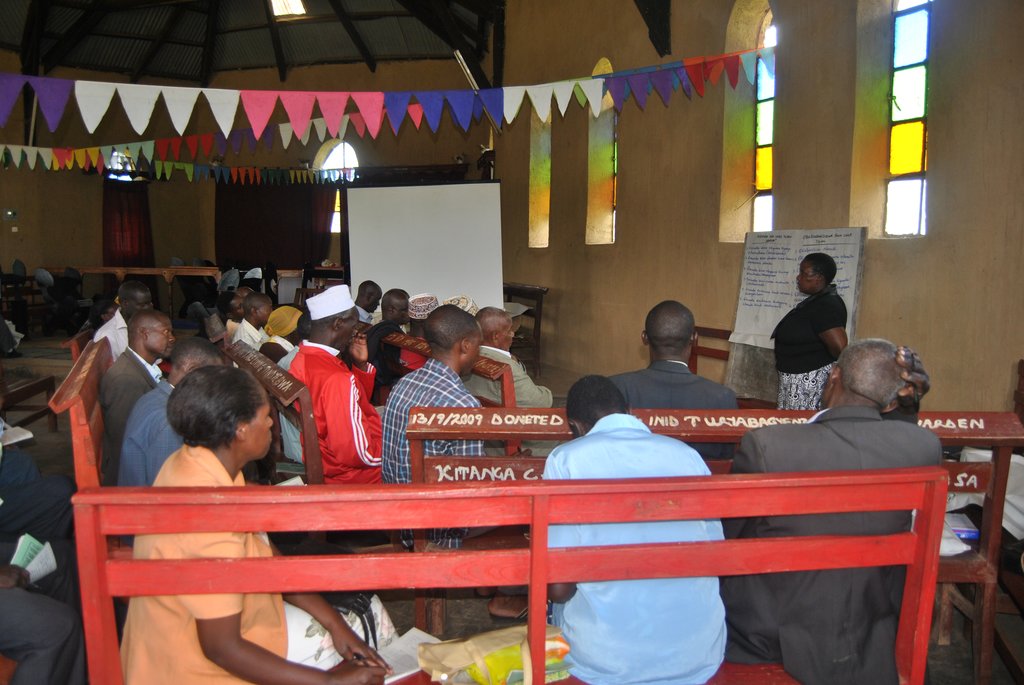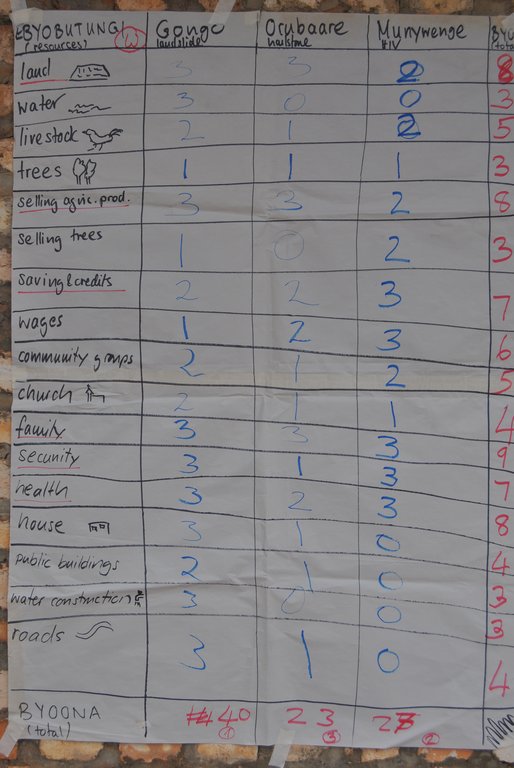Catchment Based Integrated Water Resources Management [Uganda]
- Creation:
- Update:
- Compiler: Philip Tibenderana
- Editor: –
- Reviewers: Renate Fleiner, Boris Orlowsky
Okurinda ebyobuhangwa
approaches_724 - Uganda
View sections
Expand all Collapse all1. General information
1.2 Contact details of resource persons and institutions involved in the assessment and documentation of the Approach
Key resource person(s)
SLM specialist:
Name of project which facilitated the documentation/ evaluation of the Approach (if relevant)
Book project: where people and their land are safer - A Compendium of Good Practices in Disaster Risk Reduction (DRR) (where people and their land are safer)Name of the institution(s) which facilitated the documentation/ evaluation of the Approach (if relevant)
Tear Fund Switzerland (Tear Fund Switzerland) - Switzerland1.3 Conditions regarding the use of data documented through WOCAT
The compiler and key resource person(s) accept the conditions regarding the use of data documented through WOCAT:
Ja
1.4 Reference(s) to Questionnaire(s) on SLM Technologies
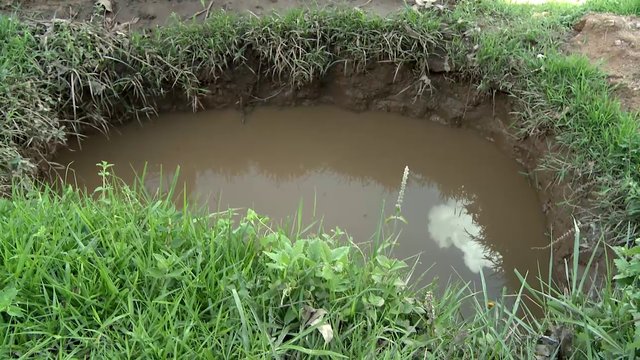
Percolation pits [Uganda]
A percolation pit is an excavation in the ground in the pathway of water runoff to intercept the flow of the water and thereby reduce erosion and destruction of crops, settlements and other infrastructure downstream
- Compiler: Philip Tibenderana
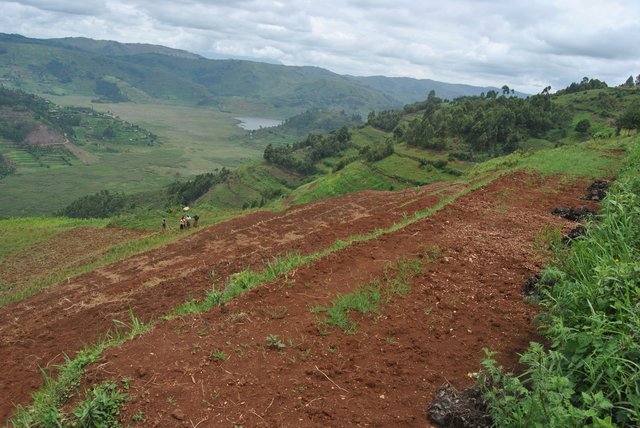
Bench Terracing [Uganda]
A bench terrace is an artificial horizontal strip dug across a steep landscape, with a riser ranging between 30 and 45 degrees. Bench terraces are constructed in series and help to minimize land degradation by rainwater runoff
- Compiler: Philip Tibenderana
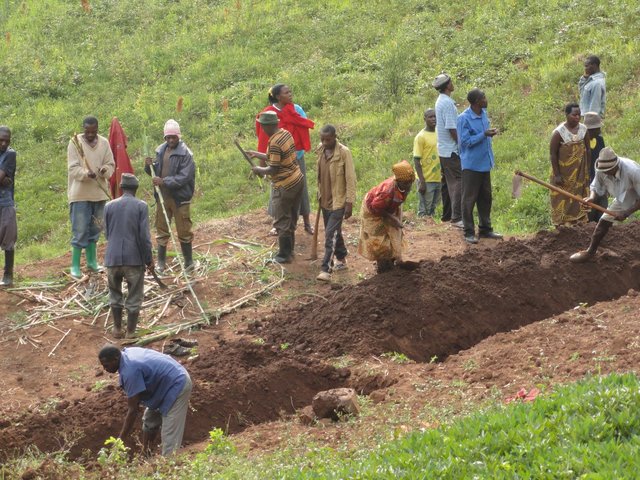
Soil and Water Conservation Channels [Uganda]
A soil and water conservation channel is an excavated trench along the contour with tie bands after an interval to trap water and soil which are being washed down the slopes by a downpour
- Compiler: Philip Tibenderana
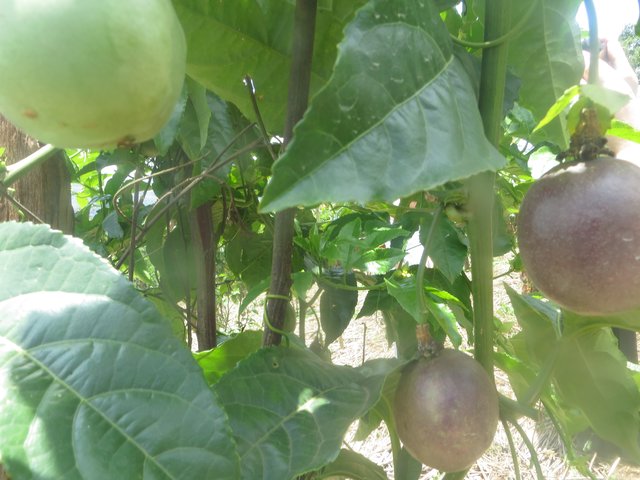
Farming God's Way [Uganda]
Farming Gods Way is a method of farming which aims to preserve soil structure through minimum tillage, mulching with grass or plant stalks and use of organic manure for improved crop yields.
- Compiler: Philip Tibenderana
2. Description of the SLM Approach
2.1 Short description of the Approach
Catchment based integrated water resources management is a process which promotes the coordinated development and management of water, land and related resources in order to maximise economic and social welfare in an equitable manner without compromising the sustainability of vital eco systems
2.2 Detailed description of the Approach
Detailed description of the Approach:
This approach brings together all the people who are using the land resources within a defined area
This approach entails community mobilisation, organisation and empowerment to jointly harness and manage their resources sustainably for optimum benefits
The process begins when a request from a community is received. This is followed by an assessment to ascertain the needs and the level of involvement of the community.
The community is then mobilised through the religious and local leaders. The leaders then facilitate formation of local environment committees which are trained
The local environment committees convene community meetings and the community does the hazard and vulnerability assessments, and identifies the adaptation strategies. The community then identifies resource user groups which are trained and supported to implement the technologies
The stakeholders involved were the church and local leaders who do the mobilisation, government technical staff for technical backup and supports enforcement of by-laws, community members who attend meetings and trainings and participate in applying the technologies, Kigezi Diocese Water and Sanitation Programme (KDWSP) which provides technical expertise and subsidises implementation of the technologies, development partners who provide funding and capacity building for implementation staff, other development agencies who share experiences
The land users appreciate the approach because it puts them at the forefront of the planning and implementation to address their problems. However, the approach is demanding in terms of time
2.3 Photos of the Approach
2.5 Country/ region/ locations where the Approach has been applied
Country:
Uganda
Region/ State/ Province:
South Western Region
Further specification of location:
Rubaya Sub County, Kabale District
2.6 Dates of initiation and termination of the Approach
If precise year is not known, indicate approximate date when the Approach was initiated:
less than 10 years ago (recently)
2.7 Type of Approach
- project/ programme based
2.8 Main aims/ objectives of the Approach
The main aim of the approach is to ensure that the water and related resources provide a source of livelihood to the people while being preserved for use by future generations and reducing resources based conflicts
2.9 Conditions enabling or hindering implementation of the Technology/ Technologies applied under the Approach
social/ cultural/ religious norms and values
- enabling
There are social groups in the communities which all community members highly conform to. Community members also are very religious and therefore the church is a very effective convener
availability/ access to financial resources and services
- hindering
People are poor because they depend on susbsistence farming, and with limited land, there is low productivity and much of what is produced is consumed
institutional setting
- enabling
Government and church structures are well established to the grass root and they are in support of development programmes
- hindering
Although good laws exist, the level of enforcement is low
collaboration/ coordination of actors
- enabling
Collaboration with other development agencies fosters learning and sharing of experiences and knowledge
legal framework (land tenure, land and water use rights)
- enabling
People own land in a manner that they are free to use it the way they want
- hindering
On the contrary, some people may not easily adopt th technology since it is at their will
policies
- enabling
Relevant policies are in place
land governance (decision-making, implementation and enforcement)
- hindering
Although policies are in place, they are not easily enforced
knowledge about SLM, access to technical support
- enabling
This approach builds on already existing local knowledge and existence of government technical teams
markets (to purchase inputs, sell products) and prices
- hindering
The farmers have low purchasing power due to poor incomes
workload, availability of manpower
- hindering
The youth and men who are the most energetic are not active and spend most their time gambling and drinking and much of the work is being done by women
3. Participation and roles of stakeholders involved
3.1 Stakeholders involved in the Approach and their roles
- local land users/ local communities
Attending meetings and trainings and participating in applying the technologies. Mostly women aged between 16 and 60
- community-based organizations
KDWSP and existing community groups like stretcher groups, local savings and credit groups
Help to convene community members for meetings and trainings and enforcing by-laws
- SLM specialists/ agricultural advisers
Training and providing technical knowledge and overseeing and supervision of technologies
- researchers
Provide resource materials
- teachers/ school children/ students
Teachers disseminate information, school children (age 8 - 15) engage in music, dance and drama with messages relating to SLM
- NGO
Sharing experiences
- private sector
Supplying inputs and provide market for the produce
- local government
Mobilisation, enforcement of policies and provide technical support
- national government (planners, decision-makers)
Make policies and guidelines and provide an enabling environment
- international organization
Provide funding and capacity building for implementing agencies
3.2 Involvement of local land users/ local communities in the different phases of the Approach
| Involvement of local land users/ local communities | Specify who was involved and describe activities | |
|---|---|---|
| initiation/ motivation | self-mobilization | When disasters hit the communities, they organised themselves, through their leaders, and approached KDWSP to support them overcome these and similar disasters |
| planning | interactive | Following the hazard and vulnerability assessments, KDWSP in partnership with the Ministry of Water and Environment, explained to communities the different technologies and their benefits and the community decided on which technologies to adopt |
| implementation | interactive | The SLM specialists guided the land users on how to implement the technologies |
| monitoring/ evaluation | interactive | The SLM specialists, together with community elected representatives carried out the monitoring of the technologies |
3.4 Decision-making on the selection of SLM Technology/ Technologies
Specify who decided on the selection of the Technology/ Technologies to be implemented:
- mainly SLM specialists, following consultation with land users
Specify on what basis decisions were made:
- evaluation of well-documented SLM knowledge (evidence-based decision-making)
4. Technical support, capacity building, and knowledge management
4.1 Capacity building/ training
Was training provided to land users/ other stakeholders?
Ja
Specify who was trained:
- land users
- field staff/ advisers
Form of training:
- on-the-job
- farmer-to-farmer
- demonstration areas
- public meetings
Subjects covered:
Water resources management policies, regulations and guidelines, community based catchment planning, principles of IWRM, IWRM implementation approaches, roles and responsibilities, soil and water conservation practices and conservation farming, soil and water conservation practices and conservation farming, setting out and construction of soil and water conservation channels (use of the A-frame), construction of percolation pits, construction of bench terraces
4.2 Advisory service
Do land users have access to an advisory service?
Ja
Specify whether advisory service is provided:
- on land users' fields
- at permanent centres
Describe/ comments:
There is a National Agricultural Research Organisation located within the District where land users can go for advisory services. There are also agricultural extension workers at sub county level and project staff who regularly follow up the land users
4.3 Institution strengthening (organizational development)
Have institutions been established or strengthened through the Approach?
- yes, moderately
Specify the level(s) at which institutions have been strengthened or established:
- local
Describe institution, roles and responsibilities, members, etc.
The formed local environment committees are comprised of community representatives, local council leaders, sub county leadership and church leaders. They are responsible for mobilising communities, planning, implementation and monitoring of the technologies
Specify type of support:
- capacity building/ training
- equipment
4.4 Monitoring and evaluation
Is monitoring and evaluation part of the Approach?
Ja
Comments:
There is routine field follow up made by KDWSP and the local environment
If yes, is this documentation intended to be used for monitoring and evaluation?
Ja
Comments:
This information will be used as a baseline for tracking progress and measuring impact
4.5 Research
Was research part of the Approach?
Nee
5. Financing and external material support
5.1 Annual budget for the SLM component of the Approach
Indicate the annual budget for the SLM component of the Approach in US$:
150000.00
Comments (e.g. main sources of funding/ major donors):
Tearfund Switzerland
5.2 Financial/ material support provided to land users
Did land users receive financial/ material support for implementing the Technology/ Technologies?
Ja
If yes, specify type(s) of support, conditions, and provider(s):
Tools for construction of the technologies, seedlings, setting up demonstration sites, training
5.3 Subsidies for specific inputs (including labour)
- labour
| To which extent | Specify subsidies |
|---|---|
| partly financed | Wages to people who construct the demonstration bench terraces. The beneficiary land user provides food for the laborers |
- equipment
| Specify which inputs were subsidised | To which extent | Specify subsidies |
|---|---|---|
| tools | fully financed | For excavation of conservation channels and percolation pits |
- agricultural
| Specify which inputs were subsidised | To which extent | Specify subsidies |
|---|---|---|
| seeds | fully financed | For establishment of hedge rows |
If labour by land users was a substantial input, was it:
- voluntary
Comments:
Labour for excavation of conservation channels and percolation pits was voluntary while labour for construction of demonstration bench terraces was paid in cash
5.4 Credit
Was credit provided under the Approach for SLM activities?
Nee
5.5 Other incentives or instruments
Were other incentives or instruments used to promote implementation of SLM Technologies?
Nee
6. Impact analysis and concluding statements
6.1 Impacts of the Approach
Did the Approach empower local land users, improve stakeholder participation?
- No
- Yes, little
- Yes, moderately
- Yes, greatly
Land users can now do the technologies by themselves, conduct meetings, enforce their own by-laws
Did the Approach enable evidence-based decision-making?
- No
- Yes, little
- Yes, moderately
- Yes, greatly
Management structures are now able to meet regularly to make decisions based on observations and lessons learnt during the implementation of the technologies
Did the Approach help land users to implement and maintain SLM Technologies?
- No
- Yes, little
- Yes, moderately
- Yes, greatly
Subsidy as part of the approach was a major support in helping to implement the technologies
Did the Approach improve coordination and cost-effective implementation of SLM?
- No
- Yes, little
- Yes, moderately
- Yes, greatly
The established community management structures are linked to sub county technical staff for technical support and other service providers like other agencies
Did the Approach mobilize/ improve access to financial resources for SLM implementation?
- No
- Yes, little
- Yes, moderately
- Yes, greatly
The approach focussed more on adoption of the technologies and did not go to the extent of training land users to mobilise financial resources
Did the Approach improve knowledge and capacities of land users to implement SLM?
- No
- Yes, little
- Yes, moderately
- Yes, greatly
Trained land users are now able to replicate the technologies with little or no external support
Did the Approach improve knowledge and capacities of other stakeholders?
- No
- Yes, little
- Yes, moderately
- Yes, greatly
Local government leaders, churches, CSOs and community leaders were equipped with knowledge on SLM and exposed to best practices
Did the Approach build/ strengthen institutions, collaboration between stakeholders?
- No
- Yes, little
- Yes, moderately
- Yes, greatly
The stakeholders occasionally meet to discuss SLM matters and other issues are discussed in that forum
Did the Approach mitigate conflicts?
- No
- Yes, little
- Yes, moderately
- Yes, greatly
Land users work together in implementation of SLM technologies which promotes cohesion
Did the Approach empower socially and economically disadvantaged groups?
- No
- Yes, little
- Yes, moderately
- Yes, greatly
The approach did not specifically target disadvantaged groups
Did the Approach improve gender equality and empower women and girls?
- No
- Yes, little
- Yes, moderately
- Yes, greatly
Women have been targeted and considered to be part of the management committees or host demonstrations
Did the Approach encourage young people/ the next generation of land users to engage in SLM?
- No
- Yes, little
- Yes, moderately
- Yes, greatly
SLM messages were disseminated through music, dance and drama by school children and youth who are next generation of land users
Did the Approach improve issues of land tenure/ user rights that hindered implementation of SLM Technologies?
- No
- Yes, little
- Yes, moderately
- Yes, greatly
By-laws formed and guidelines which were provided to the land users have helped in the implementation of the technologies
Did the Approach lead to improved food security/ improved nutrition?
- No
- Yes, little
- Yes, moderately
- Yes, greatly
The SLM have helped to reduce fertile soil loss due to erosion, increase soil moisture content and reduce destruction of crops by surface runoff hence improved productivity
Did the Approach improve access to markets?
- No
- Yes, little
- Yes, moderately
- Yes, greatly
The approach did not focus on this aspect
Did the Approach lead to improved access to water and sanitation?
- No
- Yes, little
- Yes, moderately
- Yes, greatly
The technologies under this approach protect existing water sources and sanitation facilities from destruction by surface runoff and landslides and replenish sub-surface water sources
Did the Approach lead to more sustainable use/ sources of energy?
- No
- Yes, little
- Yes, moderately
- Yes, greatly
Under this approach other technologies are integrated including energy saving stoves, agro-forestry which aim at sustainable use of the land resources
Did the Approach improve the capacity of the land users to adapt to climate changes/ extremes and mitigate climate related disasters?
- No
- Yes, little
- Yes, moderately
- Yes, greatly
The approach has led to increased adoption of the structures that minimise the impact of surface run offs on the farms of land users
Did the Approach lead to employment, income opportunities?
- No
- Yes, little
- Yes, moderately
- Yes, greatly
The approach has resulted in providing training for skilled labour. Beneficiaries are able to sell their labour and the technologies introduced create room for increased productivity from the farms of the land users
6.2 Main motivation of land users to implement SLM
- increased production
The approach delivers multiple technologies which enhance production
- reduced land degradation
Leads to reduction of soil erosion, destruction of infrastructure, improved green cover
- reduced risk of disasters
There is reduced risk of mudslides and valley bottom flooding which destroy lives, crops, livestock and infrastructure
- reduced workload
The terraced areas are easier to work on than slanting slopes
- payments/ subsidies
The subsidies reduce the initial investment costs
- rules and regulations (fines)/ enforcement
Some of the land users fear to be fined and thus resort to implement the SLM
- prestige, social pressure/ social cohesion
Some of the land users agree on what should be done and adhere to group set regulations
- environmental consciousness
Depends on the historical climate trends and creates a sense of appreciating the realities in the occurrences which motivates them to work to curb them down
- enhanced SLM knowledge and skills
Land users trained get motivated to put into practice what has been taught
6.3 Sustainability of Approach activities
Can the land users sustain what has been implemented through the Approach (without external support)?
- yes
If yes, describe how:
After learning from the demonstration technologies a number of land users have already adopted the technologies without any external support. It is hoped that this practice will continue after realising the benefits
6.4 Strengths/ advantages of the Approach
| Strengths/ advantages/ opportunities in the land user’s view |
|---|
| The approach strengthens the ability of land users coming together and working together |
| Increases land users capacity to put resources, which were thought to be useless, to better use |
| Creates more opportunities (knock-on effect), for example brick making arising from water retained in the dug percolation pits, silt in percolation pits can be used as manure and construction material like sand, goat rearing from planting hedge rows, manure from goat rearing |
| Strengths/ advantages/ opportunities in the compiler’s or other key resource person’s view |
|---|
| The approach addresses a wide range of concerns at once for example the social economic and the environmental issues |
| It incorporates social and environmental considerations directly into policy and decision making |
| It directly involves all stakeholders |
| The approach creates a balance between water being used as a resource and at the same time being preserved |
6.5 Weaknesses/ disadvantages of the Approach and ways of overcoming them
| Weaknesses/ disadvantages/ risks in the land user’s view | How can they be overcome? |
|---|---|
| The approach requires a lot of effort in terms of understanding it and implementing it | Continuous sensitization and training |
| Some of the benefits of this approach are long term | Continuous encouragement and exposure to successful areas and incorporating initiatives that realise short term benefits to keep the land users going |
| Weaknesses/ disadvantages/ risks in the compiler’s or other key resource person’s view | How can they be overcome? |
|---|---|
| The approach is complex in the sense that it is multi-sectoral (cuts across agriculture, health, environment, engineering and governance | Creating sharing platforms from the lowest to the highest level which enable continuous learning |
| Requires a lot of effort from diverse stakeholders - policy makers, policy enforcers, facilitators and implementers | Exposure of the stakeholders to successful areas helps them to appreciate the approach and adopt it |
7. References and links
7.1 Methods/ sources of information
- field visits, field surveys
- interviews with land users
- interviews with SLM specialists/ experts
- compilation from reports and other existing documentation
Periodic programme reports
7.2 References to available publications
Title, author, year, ISBN:
Kigezi Diocese Water and Sanitation Programme, IWRM Annual Report (April 2015 - March 2016)
Available from where? Costs?
www.kigezi-watsan.ug
7.3 Links to relevant information which is available online
Title/ description:
Integrated Water resources Management
URL:
www.un.org/waterforlifedecade/iwrm.shtml
Title/ description:
Integrated Water Resources Management in Uganda
URL:
www.mwe.go.ug
Links and modules
Expand all Collapse allLinks

Percolation pits [Uganda]
A percolation pit is an excavation in the ground in the pathway of water runoff to intercept the flow of the water and thereby reduce erosion and destruction of crops, settlements and other infrastructure downstream
- Compiler: Philip Tibenderana

Bench Terracing [Uganda]
A bench terrace is an artificial horizontal strip dug across a steep landscape, with a riser ranging between 30 and 45 degrees. Bench terraces are constructed in series and help to minimize land degradation by rainwater runoff
- Compiler: Philip Tibenderana

Soil and Water Conservation Channels [Uganda]
A soil and water conservation channel is an excavated trench along the contour with tie bands after an interval to trap water and soil which are being washed down the slopes by a downpour
- Compiler: Philip Tibenderana

Farming God's Way [Uganda]
Farming Gods Way is a method of farming which aims to preserve soil structure through minimum tillage, mulching with grass or plant stalks and use of organic manure for improved crop yields.
- Compiler: Philip Tibenderana
Modules
No modules


